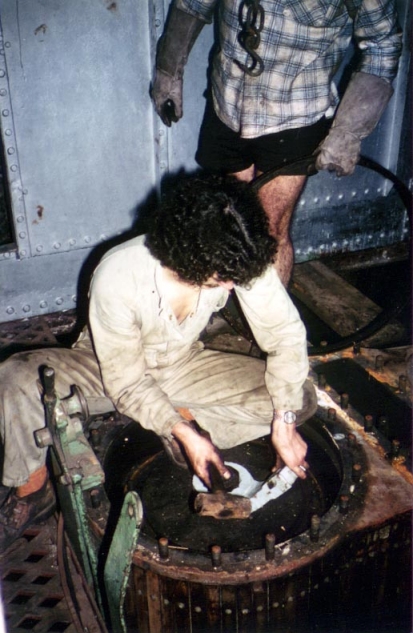Another perspective on Ship Restoration
as seen by
Andy Munns
Andy has had over 30 years experience restoring the ships of the Sydney Heritage Fleet

Click above for
Maritime History Downunder

Click above for WoodenBoats Australia
Associated
pages:
Andy on Waratah in the late 1970s.
Dear all - re "Falls of Clyde" discussion – this applies to any preserved/operating/displayed vessel.
Look at the Stockvic site - ex St Canute from Exeter museum now being looked after by a different group.
http://www.freewebs.com/stockvik/pictures.htm
and as well the work on The Sydney Heritage Fleet ship “John Oxley “
http://www.shf.org.au/JO-restoration/JO-how-it-is-done.html
Preservation of heritage ships must be commenced by people who are great at rallying support, publicity and then some fundraising plus influencing politicians, owners, business, media, etc. This is a given.
The vessels, if in good condition, are then displayed by a new generation of enthusiasts.
If restoration is needed, another type of person arrives - one who can conceptualise and progress a method of restoration - this can involve well funded conventional work or it could involve innovative and unusual concepts.
Then, a new generation of operators migrates into the vessel and it becomes theirs. Often the restoration phase is forgotten and the original skill base dissipates as people drift on, start the next restoration, or sadly pass away.
Recognition of the need to keep up the standard of the vessel often fades and a later generation of operators/displayer/etc. finds themselves with a vessel in trouble.
They also find themselves with an organisation that has lost the original skills base that initially established the vessel in display or operation.
I urge the volunteers sailing and guiding on restored vessels to drop over to look over the current John Oxley work. Here the structure beneath the main engine is being repaired - it is demanding and difficult work - ditto for the link above on Stockvic. Also examine the websites for Waverley, Virginia V and Kingswood Castle. There are many groups that record and display on www the difficult and demanding work needed to keep their projects alive.
But this is what is eventually required on ALL vessels! Resistance to the notion of eventual restoration is futile!
The hard question for people operating and displaying ships is getting to the understanding that new people bringing repair and restoration concepts are required.
This is also happening in an era where society at large is losing the practical skill base needed to work on ships – at times it seems likely that the “skills shortage” is contrived to force manufacturing and innovation offshore so that we can focus purely on the business of business.
Hence we have no local shipping and a Navy that is finding it impossible to attract sufficient crews. We also have survey authorities that are searching internationally for surveyors, as the local supply of shipwrights and engineers no longer exists.
We also have a world-wide shortage of graduate engineers in practically every field. We also have similar shortages in every technical field that is clearly harming our ability to manufacture, design, repair and innovate.
Also for the larger more well funded museums – these focus on preserving artefacts, and retaining original fabric and certainly do a great job here. But there is negligible recognition of the concept for preserving a skills base as an existing artefact.
Hence we might preserve a wagon wheel, but the skill set that knows how or why the iron tyre was shrunk on is not perceived as a physical artefact.
The challenge for the huge numbers of preserved ships will be finding the people resource that can start conceptualising the repair for their ship that will be eventually required.
Strangely enough, many successful restorations derive from people outside of the mainstream ship repair industry. In fact, people from mainstream repair backgrounds often deem a restoration impossible in those daunting days of project establishment.
For Sydney Heritage Fleet, this meant that every restoration project attracted expert predictions that the proposed restoration was commercially, mechanically and sensibly impossible.
Of course, they were right, but today, a restored James Craig proudly sails off the Australian coast with passengers.
Many successful restorations also commence via people who start the project and gather the skills and resources needed.
One thing is certain – it is rare for any organisation to raise funds and then commence a planned and sequenced restoration.
Most successful organisations must commence the project and then establish their credential through visible progress – most museum boards and sponsors will only really get behind a project when they see an already successful and happening project.
Andy Munns
